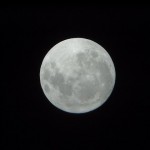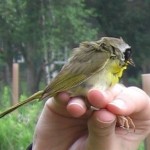Where Science, Art and Nature Come Together.
Dawn Chorus
I’m a morning person. My routine, 7 days a week, is get up, throw on some sweats, and go outside with the dog for a nice, long walk. On days when I’m working at Pfeiffer Nature  Center, that walk happens at about 5:00 a.m. Since that’s dark most of the year, I walk up my dirt road at that hour.
Center, that walk happens at about 5:00 a.m. Since that’s dark most of the year, I walk up my dirt road at that hour.
I know that seems ungodly to some people, but I really enjoy the early morning walks, particularly between April and October. I get to see the moon & stars, watch the sun come up, and listen to the true dawn chorus.
If you’re a birder, you know that the dawn chorus is the pleasant time when the birds sing their morning songs. If you’re a late sleeper, you know that too, although your name for it might be a little less favorable.
Most of my road is wooded, but at the top there are some mowed fields, so I get to hear both woodland birds and meadow birds. Because of the early hour, I rarely see any of them, so I have to rely exclusively on my ears. Not an easy task, at least not for me.

On the same fine, spring morning that the Common Yellowthroat sang his hello to me, I also heard someone else for the first time this year. With a bright, clear song that I interpret as sweet-sweet-you, it was the lovely Magnolia Warbler. He’s since been singing in my yard, too, making that positive ID easier.
Then on May 13 I heard someone new again in that meadow. The song was consistent, and I believe it to be either a warbler or a thrush, but my online searches have not helped me out yet. It’s sound? Wish I could tell you better, but it was deeee-doooo-trill. The deee was a higher note than the doooo. Pretty unhelpful, isn’t it?! When I get home I’m going to listen to my favorite resource for identifying bird calls, Birds of New York book by Stan Tekiela, with its accompanying CD of actual recorded bird song. There are many other good options out there, this just happens to be the one I have access to.
The latest newcomer to my morning ear was on May 19, when I heard my first Veery of the year. To my ear, it sounds like this little thrush is in the woods playing two notes at once on a tiny wooden pan flute. Their song is so sweet and musical, it draws me into the shaded woods.
Leave me a comment – What birds are you hearing or seeing now?
by Peg Cherre, Executive Director